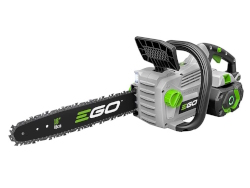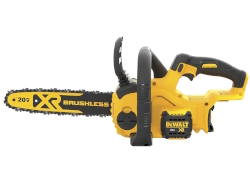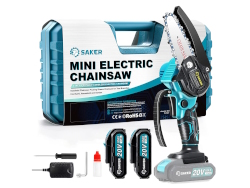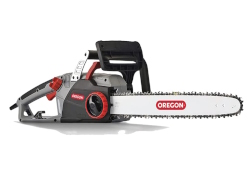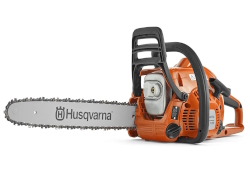Top 5 Best Chainsaws
Updated June 2023

There are times when one must cut timber and a muscle-powered hand saw just won't do. For these tough sawing tasks, you're going to need a good-quality, powered chainsaw that will effortlessly take that tree or branch down.
In order to help you make a more informed buying decision, we invested over 36 hours researching and comparing 80 different chainsaws to create this buyer's guide and list of the top ten models.
As an Amazon Associate we earn from qualifying purchases. All opinions and recommendations are strictly our own and unbiased.

Best Overall: EGO Power+ CS1804 18-Inch Cordless Chainsaw
The EGO Power+ CS1804 is, in our opinion, the best cordless chainsaw currently on the market. EGO is a household name among people who use cordless electric tools. Every battery-powered tool manufacturer seems to have its own claim to fame and for EGO it is power. They are one of the few cordless power tool makers that strive to deliver performance in their tools that rival their traditional versions, and they made no exception with the EGO chainsaw.
Coupling a powerful 40-volt motor with a 6 AH (amp hour) battery, this chainsaw can handle cutting tasks that most people would not even consider possible for a cordless chainsaw.

Best Value: DEWALT DCCS620B 20V MAX XR 12-Inch Cordless Chainsaw
If you’re looking to get the best “bang for your buck,” look no further than the DEWALT DCCS620B. This cordless 40-volt chainsaw offers relatively quiet operation for anyone who needs to cut wood in areas where a great deal of noise would be problematic.
One of the best features of this chainsaw is its sheer ability to hold a charge. And while the cutting time estimates in the marketing materials may be a tad optimistic, most users have found themselves pleasantly surprised by how long the saw can run on a single charge. Charge time, though, is pretty slow at about two hours to charge from empty to full. Because of this, anyone with a really big project may want to buy a second battery for this chainsaw.

Best Budget Model: Saker GJ15990 4-Inch Mini Cordless Chainsaw
One glance at the Saker GJ15990 Mini will tell you that this is not a chainsaw designed for lumberjacks. The cute little 4 inch bar is a good indicator of the level of cutting this unit is designed to handle. In addition to the tiny bar, the 20V batteries do not boast hours and hours of cutting time. Expect somewhere between half an hour and an hour of actual cutting time.
But having said that, it doesn’t mean that this entry-level budget chainsaw isn’t worth buying. It may lack power, but some people may prefer this model due to the fact that it’s compact, lightweight and doesn’t require a great deal of strength to handle. And even those strong enough to handle much larger saws will find that using this machine to cut is far less fatiguing than a heavier, bulkier saw.
4Best Corded Electric Chainsaw: Oregon 603352
Among corded electric chainsaws, the Oregon 603352 is our top pick. This high-end chainsaw is designed to handle anything from small tree limbs to full firewood logs. Oregon is well known for its quality within small power tool circles, and this model does nothing to diminish this well earned reputation.
The first indication of its quality is the Oregon semi-chisel chain that it comes with. Many chainsaw manufacturers equip their new saws with a cheap chain that cuts wood but tends to leave users disappointed. Its high-quality chain offers excellent cutting qualities that reduces the need to lean on the saw excessively when cutting. It also creates less kickback than a full chisel chain and has excellent run times between sharpenings.
5Best Gas-Powered Chainsaw: Husqvarna 120 38-cc 1.8-HP 16-Inch
When it comes to gas-powered chainsaws, the Husqvarna 120 is quite easily the best out there. Husqvarna, or ‘Husky’ to those who talk about saws on a daily basis, is a legendary name in chainsaws. Known for their ruggedness and power, these chainsaws are a favorite among those who use chainsaws daily as a part of their profession. Among those who are fortunate enough to own one, the most commonly used word to describe this machine is “beast”.
With a powerful 38-cc engine and 16-inch bar, the Husqvarna 120 will breeze through just about any wood sawing task it comes across, outside of a professional logging operation. The saw is also a beast in terms of construction. Weighing about 13 pounds, this is an extremely solid and sturdy tool, not a flimsy toy disguised as a chainsaw.
Chainsaw Buying Guide
Types of Chainsaws
The first, and most crucial, decision you'll need to make when shopping for a chainsaw is what type you're going to buy. There are 3 different types:
- Gas Powered
- Corded Electric
- Cordless (Battery-Powered) electric
Gas Powered
The gas powered chainsaw is the traditional choice of professional timber cutters. The torque and cut time such an engine can produce are unmatched. This choice is the right one for anyone who needs a great deal of power or who will be cutting massive quantities of material. There are a couple of disadvantages to the gas powered chainsaw, though.
First, they are loud. Virtually all gas powered chainsaws use a two stroke engine. Now, four stroke chainsaws which are much quieter than two strokes do exist, but the amount of power they can produce is far less. Since this is the case, someone who needs a quieter chainsaw would probably be better off with an electric chainsaw.
Additionally, two stroke engines are difficult to start compared to similarly sized four stroke engines. The higher power in a smaller package of a two stroke versus a four stroke results in a higher compression engine. Pulling the start cord means fighting this compression. Beyond this, they are even more difficult to start when they are hot, so turning the saw off frequently during a job is a path to much more effort.
Lastly, they require oil to be mixed into the fuel at a certain ratio for the chainsaw to perform well and last.
Gas powered chainsaws need to be frequently used. If allowed to sit for more than a month, even with fuel preservatives added, they tend to require a lot of servicing to start. A good way to somewhat alleviate this problem is to make it a policy to drain the fuel from the saw and run it until it burns out the fuel remaining in the engine itself. Doing so will minimize the chance of old fuel gumming up the system and preventing the saw from starting the next time it is needed.
Corded Electric
Corded electric chainsaws retain most of the power of a gas powered chainsaw without the hassle of dealing with an engine.
Plugged into a household outlet, a corded electric chainsaw can produce power approaching that of a similarly sized gas powered chainsaw, but does so in a much quieter manner.
The downside of these types of chainsaws, however, is that since it is a high amperage corded power tool, a corded electric chainsaw can only really be used within about 100 feet or so of an outlet. In other words, taking it off into the woods to cut timber will probably mean having to drag along a gas powered generator to provide power.
Cordless (Battery-Powered) Electric
Cordless electric chainsaws are the most recent addition to the family of chainsaws. These chainsaws use an attached battery to power the saw through cutting tasks. Like any other battery operated tool, there is a trade-off between battery life and performance. In other words, such a chainsaw will cut powerfully for a relatively brief period or less strongly for an extended time, depending on the model in question.
What cordless electric chainsaws bring to the table is the absolute portability of a gas powered model without the hassle of getting such a saw started. This type of chainsaw has found favor with those who need a chainsaw in the vehicle at all times to handle brief tasks, like clearing fallen timber from trails. Also, those who professionally use chainsaws often keep a cordless saw on board to deal with tasks that are small enough that it is not worth jumping through all the hoops of starting a gas powered chainsaw.
Both corded and cordless electric chainsaws have one advantage over their gas powered relatives. They can be stored indefinitely without worrying about whether they start when needed. This makes them the perfect option for those who rarely need to use a chainsaw.
Other Factors to Consider
Beyond the type of chainsaw to use, there are a few other things you should consider when selecting a chainsaw:
- Manual or Automatic Oiling
- Ease of Sharpening and Bar Adjustment
- Chain Brake System
- Chain and Bar Versatility
Manual or Automatic Oiling
Chainsaws require adequate lubrication of the chain and bar to keep heat down and make them last as long as possible.
With automatic oiling systems, a reservoir on the saw is filled with oil and the chainsaw self lubricates as it cuts. While this option does offer the peace of mind of not worrying about whether the chain needs to be lubricated at any given time, experienced chainsaw users often feel that the automated oiling systems waste oil, lubricating more than necessary.
Also, automated systems are well known among chainsaw enthusiasts as a likely cause of puddles of oil wherever the saw is stored. Depending on the individual saw, there are workarounds, like emptying the reservoir before storage, but the bottom line is a chainsaw with an automated oiling mechanism is almost certain to make more of a mess than one without.
Manual Oiling systems can mean no system at all, where the person using the saw just periodically squirts oil onto the saw during use, or a reservoir with a manual activation. While the person using a saw without automated oiling does have the control to determine how often and how thoroughly to lubricate, it does mean a person using such a saw should be experienced enough to know when to lubricate.
Ease of Sharpening and Bar Adjustment
Much of whether someone is happy with a chainsaw is determined by how much trouble it is to sharpen the chain and adjust the bar. Most gas powered chainsaws, for example, allow the owner to sharpen the chain while it is on the saw. Most electric models, on the other hand, require the chain to be removed for sharpening. Since a sharp chain is essential to quick, safe cutting, knowing what you are getting in to is a good idea.
The concept applies to making bar adjustments, too. Adjusting the bar is necessary to fine tune how tightly the chain rests on the saw. Too loose and the chainsaw will cut poorly and be more likely to throw the chain off the bar. Too tight and the saw loses power and adds a great deal of wear to the chain and bar, making them need replacement too often.
Like automatic oiling, opinion is split on whether tool free adjustment systems are a good thing. They definitely are easier to make adjustments with and do not require the owner to keep track of an adjustment tool. On the other hand, many feel that the tool free systems do not maintain tension as well as tooled systems, resulting in more frequent adjusting.
Chain Brake System
The type of chain brake system on a saw will largely determine how dangerous the saw is in the hands of an unskilled user. There are two general chain brake features: the kind that stops the chain when the trigger is released and the kind that stops the chain when the saw isn't held in a certain position.
The first type is designed to prevent injuries when the saw is not being used. A shocking number of chainsaw injuries have been caused because someone took a break, set the chainsaw down and later leaned against the still spinning chain. The chain stopping instantly is practically a universal feature on electric chainsaws, but more rare on gas powered models.
The second type of chain brake is designed to prevent injuries when the saw is actually cutting. Occasionally when cutting, the saw will bind or hit a knot or nail embedded in the wood, stopping the chain dead and causing the chainsaw to buck. This is called kickback. Chain brakes that deal with kickback involve a moving handle on the chainsaw with a sensor that activates the brake when the saw is not in the proper cutting grip. In the event of a saw kicking back toward the user, having the chain still spinning is a bad thing.
Chain and Bar Versatility
There is a vast array of bar sizes and chain configurations available for chainsaws. Whether a given saw allows them to be used determines how versatile, and sometimes costly, the saw is to own. Gas powered saws are the kings of this category. Virtually any gas powered chainsaw will allow the use of different bars and chains. Electric chainsaws are often more limited. The ability to easily change the bar and chain allows the chainsaw owner to use a specialty setup or simply switch over to a combination for which the local hardware store carries parts.
There is really only one crucial consideration when buying a chainsaw: what type to buy. Those who need a portable powerhouse that can make hundreds of cuts a day through heavy timber want a gas powered model. People who desire nearly as much power in a quieter model for tasks around the house might prefer a corded electric chainsaw. Anyone who wants a completely portable option that can be deployed at a moment's notice with no effort could be looking for a cordless chainsaw.

